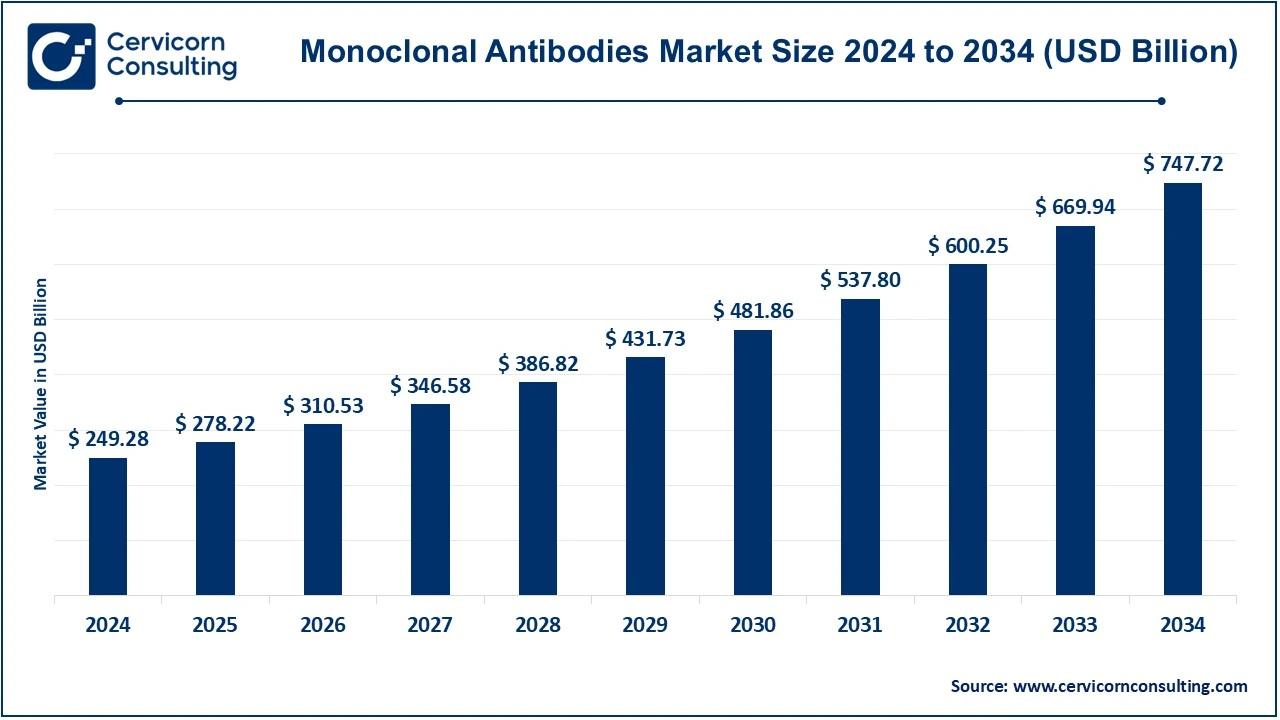Monoclonal Antibodies Market Overview
The global monoclonal antibodies market was estimated at USD 249.28 billion in 2024 and is projected to surge to USD 747.72 billion by 2034, expanding at a CAGR of 11.61% between 2025 and 2034. Monoclonal antibodies have become a pivotal force in modern biopharmaceuticals, offering highly targeted treatments across oncology, immunology, neurology, and infectious diseases. Market expansion is fueled by the growing burden of chronic illnesses, advances in biotechnology, and improved healthcare infrastructure in emerging economies.
Key Market Trends
Advancements in Biotechnology
Innovations such as antibody-drug conjugates (ADCs) and bispecific antibodies are enhancing treatment precision while reducing side effects. These technologies are gaining traction, particularly in oncology and autoimmune therapies.
Rise of Personalized Medicine
mAbs are increasingly at the core of precision therapeutics, designed to target specific disease biomarkers. For example, HER2-targeted treatments like trastuzumab have transformed breast cancer care.
Integration of AI in Drug Development
Artificial intelligence is revolutionizing mAb research by identifying novel targets, optimizing production workflows, and expediting clinical trials—ultimately lowering costs and boosting efficiency.
Government Funding and Support
Public-private collaborations, research grants, and tax incentives are driving R&D initiatives in monoclonal antibodies, helping accelerate the launch of new therapies.
Diversification of Therapeutic Use
While oncology remains a key focus, monoclonal antibodies are being increasingly applied in neurological, autoimmune, and infectious disease treatments, strengthening the market’s long-term growth trajectory.
Market Drivers
-
Rising Chronic Disease Burden: Growing incidences of cancer, diabetes, and autoimmune disorders are fueling demand. Widely adopted mAbs like trastuzumab and rituximab are central in breast cancer and lymphoma therapies.
-
Technological Innovations: Hybridoma and recombinant DNA technologies enable more efficient and cost-effective mAb production.
-
Emerging Market Expansion: Rising healthcare investments in developing regions are driving adoption and accessibility.
-
Regulatory & Government Backing: Funding and clinical trial support are accelerating therapeutic development.
-
Wider Clinical Applications: Treatments such as adalimumab and infliximab are expanding the reach of mAbs into conditions like rheumatoid arthritis and Crohn’s disease.
Impact of Trends and Drivers
-
Regional Growth:
-
North America leads with a 46.6% share (2024) due to strong healthcare systems and high adoption of biologics.
-
Europe follows with 25.1% share, supported by favorable regulations.
-
Asia-Pacific stands out as the fastest-growing region, driven by rising healthcare investments.
-
-
Segmental Insights:
-
Oncology dominates with 49.4% share (2024) as the leading therapeutic area.
-
Hospitals remain the largest end-users (39.6%).
-
In-vitro production accounts for 77.2% share, while human-sourced mAbs lead with 54.5%, thanks to their high efficacy.
-
Challenges & Opportunities
-
Challenges: High production costs and strict regulatory compliance often delay product launches.
-
Opportunities: Growth potential lies in AI-driven discovery, biosimilar development, and expansion into untapped emerging markets.
Future Outlook
The monoclonal antibodies market is on track for strong expansion, projected to reach USD 747.72 billion by 2034 at a CAGR of 11.61%. With ongoing advancements in biotechnology, rising demand for personalized therapies, and supportive regulatory policies, mAbs are set to remain at the forefront of biopharmaceutical innovation and global healthcare solutions.



